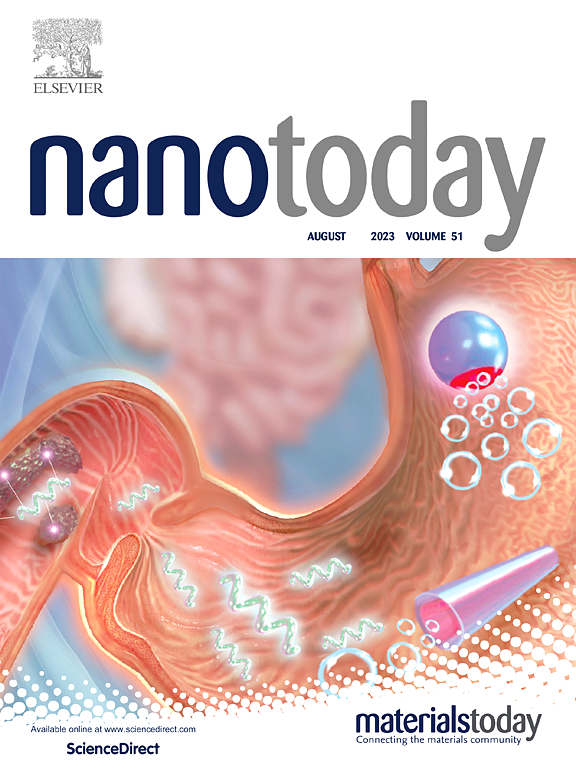18F-labeled ultrasmall nanoparticle probe for long-term PET tracking and real-time quantitative analysis of transplanted T lymphocytes in situ based on bioorthogonal reaction
IF 10.9
1区 材料科学
Q1 CHEMISTRY, MULTIDISCIPLINARY
引用次数: 0
Abstract
The real-time, accurate understanding of the biodistribution of transplanted therapeutic cells is critical for their development and application. Positron emission tomography (PET) imaging has the potential to realize the noninvasive and quantitative evaluation of the spatial-temporal distribution of transplanted cells due to its unlimited tissue-penetration depth and quantitative capabilities, but its utility is limited by various shortcomings of existing imaging strategies or probes, such as the short half-life of the commonly used radioisotope fluorine-18 (18F) and the interference of high nonspecific background signals to the exact localization and quantification of target cells. Here, we describe a new strategy for the long-term PET tracking and real-time quantitative analysis of transplanted cells based on a tetrazine-bearing, 18F-labeled ultrasmall rare-earth nanoparticle probe (Tz-[18F]NaGdF4) capable of labeling trans-cyclooctene (TCO) pretagged T lymphocytes via a bioorthogonal reaction at any point after their transplantation. The ultrasmall Tz-[18F]NaGdF4 is readily prepared and characterized by rapid renal clearance and low nonspecific accumulation in major organs. The specific reaction between the Tz-[18F]NaGdF4 probe and pretagged cells under physiological conditions enabled the specific PET imaging of target cells with low background in situ, and the measured PET image-derived standardized uptake value linearly and positively correlated with the number of pretagged T lymphocytes retained in tissues, ensuring their accurate quantification based on real-time PET signals. Therefore, the bioorthogonal reaction-based Tz-[18F]NaGdF4-PET represents a useful tool for the long-term tracking and real-time quantification of transplanted cells in vivo.
基于生物正交反应的18f标记的超小纳米颗粒探针用于移植T淋巴细胞的长期PET跟踪和实时原位定量分析
实时、准确地了解移植治疗细胞的生物分布对其开发和应用至关重要。正电子发射断层扫描(PET)成像由于其无限的组织穿透深度和定量能力,有可能实现移植细胞时空分布的无创定量评估,但其实用性受到现有成像策略或探针的各种缺点的限制。例如常用的放射性同位素氟-18 (18F)的半衰期短,以及高非特异性背景信号对目标细胞精确定位和定量的干扰。在这里,我们描述了一种新的策略,用于移植细胞的长期PET跟踪和实时定量分析,该策略基于含四氮,18F标记的超小稀土纳米颗粒探针(Tz-[18F]NaGdF4),能够在移植后的任何时间点通过生物正交反应标记反式环烯(TCO)预标记的T淋巴细胞。超小Tz-[18F]NaGdF4易于制备,具有肾清除快、主要器官非特异性蓄积低的特点。Tz-[18F]NaGdF4探针与预标记细胞在生理条件下的特异性反应,使得低背景下靶细胞的原位特异性PET成像得以实现,测得的PET图像衍生的标准化摄取值与组织中保留的预标记T淋巴细胞数量呈线性正相关,确保了基于实时PET信号的准确定量。因此,基于生物正交反应的Tz-[18F]NaGdF4-PET是长期跟踪和实时定量体内移植细胞的有用工具。
本文章由计算机程序翻译,如有差异,请以英文原文为准。
求助全文
约1分钟内获得全文
求助全文
来源期刊

Nano Today
工程技术-材料科学:综合
CiteScore
21.50
自引率
3.40%
发文量
305
审稿时长
40 days
期刊介绍:
Nano Today is a journal dedicated to publishing influential and innovative work in the field of nanoscience and technology. It covers a wide range of subject areas including biomaterials, materials chemistry, materials science, chemistry, bioengineering, biochemistry, genetics and molecular biology, engineering, and nanotechnology. The journal considers articles that inform readers about the latest research, breakthroughs, and topical issues in these fields. It provides comprehensive coverage through a mixture of peer-reviewed articles, research news, and information on key developments. Nano Today is abstracted and indexed in Science Citation Index, Ei Compendex, Embase, Scopus, and INSPEC.
 求助内容:
求助内容: 应助结果提醒方式:
应助结果提醒方式:


